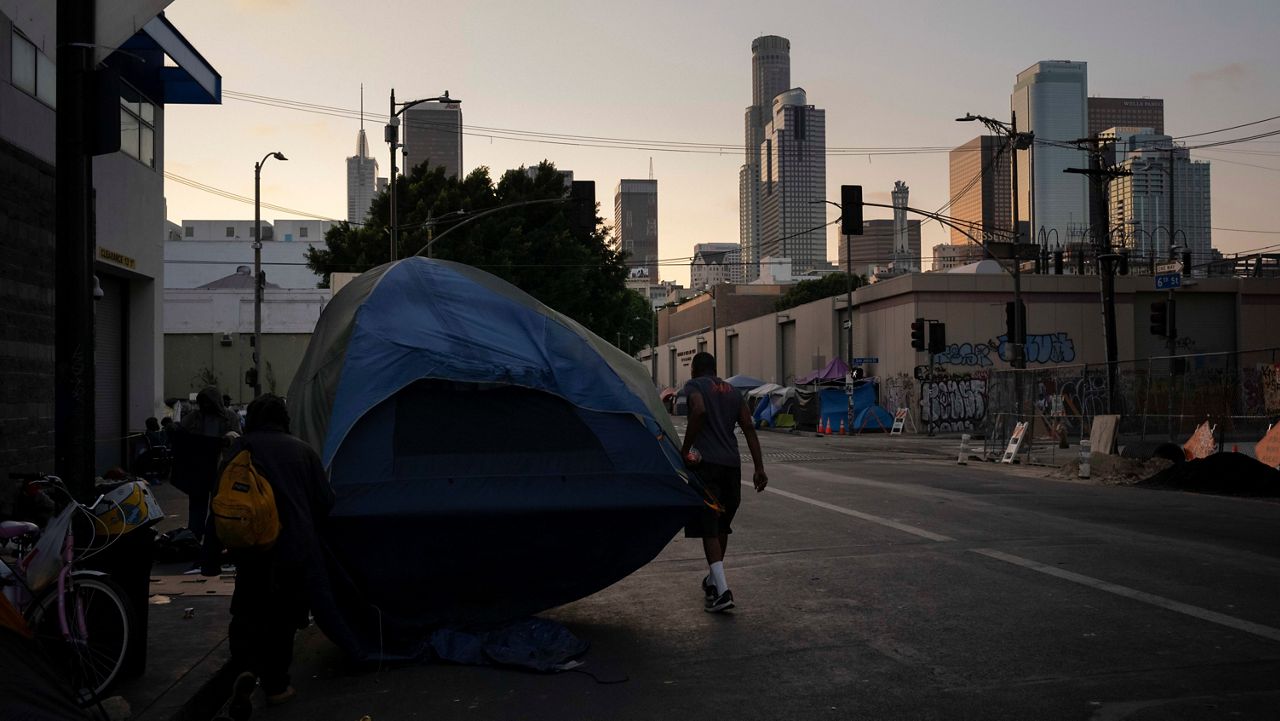LOS ANGELES — Some 1,975 people on Skid Row were moved into interim housing and another 990 people found permanent housing as a result of a state grant, Los Angeles County officials announced Monday.
What You Need To Know
- In 2023, the county received $60 million from Gov. Gavin Newsom's Encampment Resolution Fund, which is in part intended to expand housing and services on Skid Row
- In addition to the individuals moved indoors, the funding also resulted in 8,000 people, who are experiencing unsheltered homelessness in the county, obtaining outreach or health services during the first year of the grant
- County officials also made headway into its Skid Row Action Plan, an initiative designed to improve living conditions and transform the downtown neighborhood into a safe and thriving community
- There are 3,791 people experiencing homelessness in Skid Row, 2,112 of them unsheltered — the densest concentration of people experiencing homelessness in the county — according to the 2024 Greater Los Angeles Homeless Count
In 2023, the county received $60 million from Gov. Gavin Newsom's Encampment Resolution Fund, which is in part intended to expand housing and services on Skid Row. In addition to the individuals moved indoors, the funding also resulted in 8,000 people, who are experiencing unsheltered homelessness in the county, obtaining outreach or health services during the first year of the grant.
"This grant propelled our work in Skid Row and made it possible to serve thousands of vulnerable individuals and get them off the streets and into housing," Housing for Health Deputy Director Elizabeth Boyce said in a statement. "We are thankful for the grant and know that we will continue in the coming years to move even more people indoors and help them on their path toward stability."
County officials also made headway into its Skid Row Action Plan, an initiative designed to improve living conditions and transform the downtown neighborhood into a safe and thriving community.
The three-year state grant is funding several projects, which includes increasing temporary and permanent housing options, the launch of the county's 24/7 "Safe Landing" space at the Cecil Hotel for walk-ins, trauma-informed training for interim housing providers and an air traffic access center to move people into temporary housing more quickly, according to the Department of Health Services.
There are 3,791 people experiencing homelessness in Skid Row, 2,112 of them unsheltered — the densest concentration of people experiencing homelessness in the county — according to the 2024 Greater Los Angeles Homeless Count. This year's results showed a 14% drop in homelessness and a 22% drop in unsheltered homelessness in Skid Row.
"I am extremely grateful to Gov. Gavin Newsom for awarding Los Angeles County $60 million from the state of California's Encampment Resolution Fund Program to support Skid Row residents," County Supervisor Hilda Solis said in a statement, who represents the 1st District, which includes Skid Row. "...We know that more resources are needed in this area to help overcome the consequences of structural and systemic inequalities."
Data collected from the first year showed that older residents particularly benefited from the Encampment Resolution Fund, as 34% of people placed in permanent housing were aged 55 and older. The grant also focused heavily on women, placing 453 in permanent housing and 737 in interim housing.
The Every Woman Housed program, which is designed to end homelessness for women and families in Skid Row, helped make those placements possible and contributed to an overall 42% drop in unsheltered women in the neighborhood from 2022 to 2024, according to the 2024 homeless count data.
LA County implemented its Skid Row Action Plan in June 2022, when the Department of Health Services' Housing for Health began working with stakeholders to develop a proposal aimed at addressing Skid Row. The final report details several recommendations made by the people who live and work in the area.
The initiative also addresses the alarming overdose mortality rate in the area, which is the highest in the county. The plan also leverages Measure H funding from the county's Homeless Initiative, Care First Community Investment, Los Angeles Homeless Services Authority and other sources.
The next steps for the Skid Row Action Plan include expanding job and entrepreneurship opportunities and building a campus that will include a harm reduction health hub, a safe services outdoor space and a residential care facility for people who need additional help staying permanently housed.



